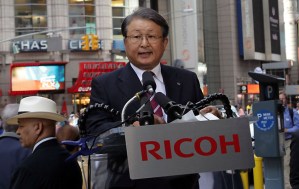
Japanese electronics giant Ricoh says it plans to cut some 10,000 jobs from its global workforce of over 100,000 as the company looks to streamline operations and shore up its bottom line in the face of strong competition. Ricoh is a leading maker of office and digital imaging equipment: the company just announced a color electronic paper display suitable for ereaders, and until now the company had successfully been weathering both the global economic downturn that started in 2008/2009 and the affects of a strong Japanese yen making its products more expensive in international markets.
Company president Shiro Kondo indicated no areas of the company would be exempt from potential cutbacks and restructuring, although he offered no details of where the job cuts would fall. The layoffs are expected land over the next three years, and Kondo also indicated the company was looking to shift some 15,000 employees to business segments that have high growth potential—such as IT services—which means the company may be shutting down some of its long-standing but less-profitable businesses.
Ricoh attributes some of its troubles to a growing rise of paperless corporate cultures in developed nations, which have reduced the demand for document printing and production equipment central to some of Ricoh’s businesses. However, while the company did have some of its Japanese production facilities impacted by the recent Japan earthquake, Ricoh says it is back in full operation. About 40,000 of the company’s employees are located in Japan, while the rest are overseas.
The move comes just weeks after Japanese electronics giant Panasonic announced it planned to cut some 17,000 employees in order to be more competitive with firms in places like China and South Korea.


